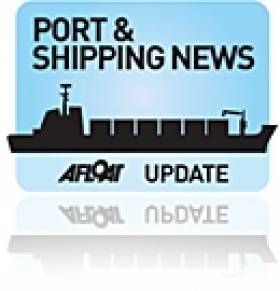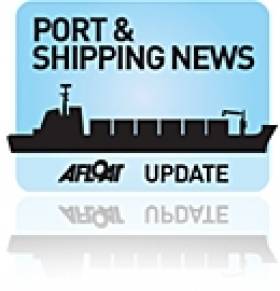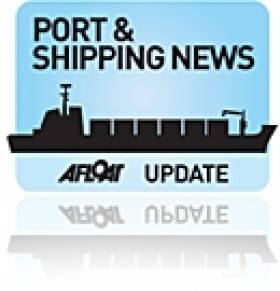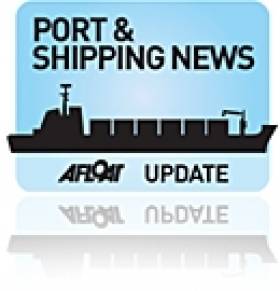Displaying items by tag: Port and Shipping News
IMDO Shipping Review: Shipping Optimistic Outlook, First Ethane-Fuelled Orders, Irish CEO's Express Confidence and much more
#Ports&Shipping –The latest IMDO Weekly Shipping Market Review includes the following stories as detailed below.
Shipping Industry: Optimistic outlook - A majority of shipping companies expect their turnover and profits to increase during 2014, according to a survey from German shipping lender HSH Nordbank, as reported by Lloyd's List. Of the 51 companies surveyed, 59% reported expectations of increased sales during the current year, with 43% projecting rising profits.
Technology & Innovation: First orders for ethane-fuelled vessels - Three new ethane-powered ships or liquefied ethylene gas carriers (LEGCs) – the first vessels to be powered by ethane – have been ordered by Ocean Yield ASA of Norway, according to Ship & Bunker. Man Diesel, suppliers of the ships' engines, advocates the benefits of ethane as a fuel alternative. They claim ethane is less expensive and requires less bunkering time than heavy fuel oil (HFO).
Irish Economy: CEO confidence rising - A CEO Pulse survey carried out by PwC saw 86% of Irish CEO's expressing their confidence regarding Ireland's economy. The survey was based on the views of 250 CEOs in Ireland and saw an increase of 31% in positivity from CEOs when compared to the same time last year. Despite respondents showing a considerable increase in positive sentiment towards the wider economy and their own businesses, many still reported challenges facing their businesses in the coming years with 86% viewing the increasing tax burden as a major challenge
For more on each of the above and other stories click the PDF downloadable IMDO Weekly Markets Review (Week 30). In addition to coverage on Afloat.ie's dedicated Ports & Shipping News.
Ports & Shipping Review: First Irish Maritime Forum, Galway's Liner Tender Ties, Ireland Sign Maritime Labour Convention
#Ports&ShippingReview: Over the last fortnight, Jehan Ashmore has reported on the shipping scene, where the Port of Cork is to host the first Irish Maritime Forum on 26 September.
The forum themed 'Developing the Dynamic Future for Ireland's Maritime Sector' will focus on exploring the future of the maritime sector within Ireland and will look closely at the challenges and opportunities faced by many within the sector.
Having made an anchorage call off Galway Harbour, Holland America Line's 800 passenger Prinsendam and her fleet of tenders leave in their wake strong ties with the mid-west port.
Minister for Transport, Tourism and Sport,Paschal Donohoe TD, and the Minister for Jobs, Enterprise and Innovation, Richard Bruton TD, announced the ratification by Ireland of the Maritime Labour Convention, which sets standards for working and living conditions for seafarers.
Dublin Port Company's 2013 Annual Report is now available as an 'online' version. The report in both Irish and English is downloadable in PDF format as well as an HTML version are now available through this LINK.
Government Ratify Maritime Labour Convention
#MaritimeConvention -Minister for Transport, Tourism and Sport, Paschal Donohoe TD, and the Minister for Jobs, Enterprise and Innovation, Richard Bruton TD, have announced this week the ratification by Ireland of the Maritime Labour Convention, which sets standards for working and living conditions for seafarers.
The Convention will improve working and living conditions for ship workers making the maritime sector more socially responsible.
This means that from 21 July 2015, Ireland will be a party to the Convention and will implement the requirements contained therein, both for Irish-flagged ships and for international ships calling at Irish ports.
In the meantime, work is progressing on the inspection and certification of Irish ships in preparation for entry into force of the Convention for Ireland.
A Declaration of Maritime Labour Compliance – Part I has been issued to all Irish-flagged vessels of 500 Gross Tonnage or more which operate internationally, and ship owners have completed a Declaration of Maritime Labour Compliance – Part II.
Work is also underway on preparing for port State control inspections for foreign-flagged ships in Ireland when the Convention enters into force here.
Minister Donohoe said: 'I am delighted that Ireland has now ratified this Convention, which underlines our commitment to maritime safety and to improved living and working conditions for seafarers. Implementation of the Convention will improve Ireland's international maritime reputation, as well as ensuring that seafarers enjoy better conditions, and that the shipping sector generally becomes a more secure and socially responsible sector'.
Minister for Jobs, Enterprise and Innovation, Richard Bruton TD, whose Department has overall responsibility for ILO matters, also welcomed the ratification, saying: 'I am very happy to welcome the ratification of this important international labour standard. This Convention will improve working and living conditions for workers on board ships and should lead to more secure, better-protected and responsible maritime employment. Ireland is fully behind the ILO's efforts to define international labour standards in this important sector'.
IMDO Shipping Review: Ultra-Large Vessel Order Slow, Tanker Carries Cars & Boxes, Shipping Firms Join Sulphur Alliance and much more
#Ports&Shipping –The latest IMDO Weekly Shipping Market Review includes the following stories as detailed below.
Container Market: Ultra-large vessel orders slow - Ordering of new containerships slowed significantly during the month of June, as European traffic demand began to increase, signalling a potential change of fortunes for the sector. Seatrade Global reported that the slowdown in growth of the orderbook, particularly amongst ultra-large vessels, marks a positive sign that improving demand could catch-up with the projected vessel supply by 2016.
Technology & Innovation: Tanker which also carries cars & boxes to set sail - Russian Ship owner BF tanker will take delivery of ten unique tankers that haul oil products, boxes and vehicles, Lloyd's List reported. Designed primarily to carry oil products, the ships will also have the capacity to handle containers and vehicles. The chief executive of BF tanker, Sergey Chaplygin, explained the project as "unique as it can provide backhaul shipments of containers and other general cargoes inincluding oversized industrial equipment."
Regulation: Shipping firms join to ensure sulphur emission compliance- A group of shipping companies with worldwide operations have joined together to form the 'Trident Alliance', aimed at ensuring robust enforcement of stricter sulphur emission standards, TradeWinds reported. The body was formed by ship owners and operators who share a common interest in the clear implementation of current and future marine sulphur regulations.cluding oversized industrial equipment."
For more on each of the above and other stories click the PDF downloadable IMDO Weekly Markets Review (Week 29). In addition to coverage on Afloat.ie's dedicated Ports & Shipping News.
#Ports&Shipping –The latest IMDO Weekly Shipping Market Review includes the following stories as detailed below.
Container Market: Maersk, MSC agree post-P3 vessel sharing agreement - With the failure of the P3 alliance, vetoed by China, Maersk Line and Mediterranean Shipping Company (MSC) have entered a 10-year vessel sharing agreement, Seatrade Global has reported. This agreement, dubbed the 2M agreement, will see the two companies collaborate on Asia-Europe, transatlantic and transpacific routes. The original alliance which also included CMA CGM was rejected by China who saw the agreement between the three largest container carriers in the world as a merger.
Tanker Market: LNG newbuild investment approaches $5bn so far this year - The demand for LNG ships has shot up this year with orders coming to $4.6bn, according to Lloyd's List. Twenty-three contracts for the building of new LNG carriers have been signed so far this year, at a rate of almost one a week. The interest of investors has been attracted by expectations that new cargoes will be introduced into the market once these new ships are in operation.
Logistics: Route approved by Nicaragua for $40 billion canal linking oceans - A $40 billion shipping channel across Nicaragua was approved by a national committee recently, Reuters has reported. The 172 mile route from the mouth of the Brito River on the pacific side to the Punto Gorda River on the Caribbean was proposed by executives from the HK Nicaragua Canal Development Co Ltd and will measure between 230 meters and 520 meters wide and 27.6 meters deep.
For more on each of the above and other stories click the PDF downloadable IMDO Weekly Markets Review (Week 28). In addition coverage of Afloat.ie's Ports & Shipping News.
Ports & Shipping Review: Urgent Call on Sulphur Rules, Dublin Port €8m Dividend, CSO Cite Growth, Losses at H&W and more
#Ports&ShippingReview: Over the last fortnight, Jehan Ashmore has reported on the shipping scene, where the European Sustainable Shipping Forum has called on European shipowners and port authorities for urgent clarification of rules regarding use of sulphur scrubbers due on 1 January 2015.
Dublin Port Company paid a dividend of €8m to the State based on its financial results for year 2013.
During the Legenderry Maritime Festival which culminated with a send-off farewell of Clipper Race yachts, the host port also celebrated their 160th anniversary.
A port snapshot of shipping activity on Waterford Estuary revealed an eclectic range of vessels involving foreign naval patrolboats, a luxury €13m sale-listed motoryacht and a livestock carrier trading to Libya.
In addition to the WD Mersey a dredger carrying out operations along the estuary for the Port of Waterford Company.
The Irish economy grew according to CSO in that there was a 2.7% increase in GDP in Q1 this year compared to same period 2013. As for GNP this rose by 0.5% over the same quarter this year.
Harland & Wolff, the shipbuilder-turned renewable energy giant manufacturer, suffered a £3.8m loss in 2013, according to newly-filed results.
Samskip Multimodal announced a new part-load services (LCL/groupage) between Italy and Ireland offering an alternative to traditional road haulage part load services.
IMDO Shipping Review: Box Volumes in N. Europe Rise, US Shale Drive LPG Market, Congestion at European Ports and more
#Ports&Shipping –The latest IMDO Weekly Shipping Market Review includes the following stories as detailed below.
Container Market: Box volumes at North European ports to maintain growth - Box traffic in Northern Europe's six largest ports will rise by 6.9% in the latter half of 2014, Lloyd's List has reported. According to the latest Global Port tracker report published by Hackett Associates and the Institute of Shipping Economics and Logistics, imports will increase 5.1% and exports 2.5% throughout Europe during the six-month period.
Tanker Market: US Shale to drive LPG market and tanker demand- Record shipments of liquefied petroleum gas (LPG) from the US, resulting from increasing shale oil production, is set to cause rising tanker demand, Bloomberg has reported. US exports of LPG – used primarily for cooking, heating and in the petrochemicals industry as a feedstock – reached record levels of 506,000 bpd during April, according to the Energy Information Administration (EIA), as production has gradually risen in response to higher oil prices and improved techniques for extraction of gas trapped in shale rock.
Ports: Congestion at European ports set to continue -Rising congestions at North European ports is set to continue as vessel sharing alliances develop, the latest research from Drewry indicates. A number of factors have led to the current congestion, particularly at Rotterdam and Hamburg. Upgrading of existing facilities and larger volume surges resulting from the increased average size of box ships have both placed constraints on terminal capacity.
For more on each of the above and other stories click the PDF downloadable IMDO Weekly Markets Review (Week 27). In addition to coverage on Afloat.ie's dedicated Ports & Shipping News section.
New Italy-Ireland Part-Load Services
#Port&Shipping – Samskip Multimodal, have announced a new part-load services (LCL/groupage) between Italy and Ireland offering an alternative to traditional road haulage part load services.
The new service is in addition to Samskip's existing full container loads.
Samskip will operate two weekly departures, combining the Milano-Rotterdam rail service and two weekly Rotterdam-Dublin sailings served on Tuesdays and Fridays. This will enable Samskip to provide fast deliveries for a competitive price while saving on CO2 emissions.
The new service's distribution network in Italy, brings an efficient shortsea service. This coupled with the Dublin-based distribution centre, is able to deliver cargo within one day of the capital's area and within 48 hours to the rest of Ireland after the arrival of the vessel.
#UnderwaterWaterford – Following our port snapshot of Waterford Harbour shipping this morning which included a dredger, INFOMAR takes us on a 3D-fly-through of the estuary (in reverse direction) showing the seabed as its winds its way upriver to the city, writes Jehan Ashmore.
The 3D imagery shows (click link, scroll down and enlarge video) the varying depths and channel widths of the shipping lane along Waterford estuary taken from the research vessel, the RV Keary.
As mentioned above this is where a dredging campaign is currently underway, notably for ships using Belview Por, the main terminal facility of the Port of Waterford Company which has contracted WD Mersey (1983/1,696grt) to carry out the work.
Since late last month dredging operations along the estuary has involved the spoil to be dumped south-west off Hook Head.
As for the role of RV Keary this took place in 2011 and was the first INFOMAR survey leg to be carried out by the South African built aluminium constructed catamaran. The survey took two-months to complete and was conducted in preparation to hosting the second Tall Ships Festival held that year.
The seabed survey mapping of RV Keary concentrated on the navigational channel while the surrounding shallower waters were tasked to a smaller RIB based craft, RV Geo. Together this was the first occasion the pair of GSI vessels worked on a survey.
The 15m RV Keary is a state-run marine research survey vessel commissioned for and operated by the Geological Survey of Ireland (GSI). As reported in 2012, the Central Fisheries Board cutter Cosantoir Bradan was chartered by GSI in an RV role.
The vessels primary function is to provide an inshore survey capability for the national INtegrated Mapping FOr the Sustainable Development of Ireland's MArine Resource - in short INFOMAR.
In addition assistance in the INFOMAR programme which is funded by the Department of Communications, Energy and Natural Resources, is also made available from the Marine Institute's pair of research vessels, RV Celtic Voyager and larger fleetmate RV Celtic Explorer.
To keep track of GSI vessels current locations, click this map-link.
CSO Say Economy Grew by 2.7% in First Quarter
#Ports&Economy - Public finances look likely to substantially overshoot the Government's deficit target for this year, reports The Irish Times, following the release of new positive data on the economy.
Experts are speculating that the Goverment could cut its planned Budget adjustment for next year by half in money terms, to €1 billion from €2 billion, and still bring in a deficit of below three per cent of Gross Domestic Product.
The latest Quarterly National Accounts, which were published this morning by the Central Statistics Office, indicate that on a seasonally-adjusted basis there was a 2.7 per cent increase in Gross Domestic Product (GDP) in the first quarter of this year compared to the fourth quarter of last year.
Gross National Product (GNP) rose by 0.5 per cent over the same period.






































































